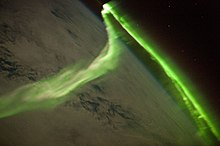The Carrington Event[1] was a powerful geomagnetic storm on 1–2 September 1859, during solar cycle 10(1855–1867). A solar coronal mass ejection (CME) hit Earth's magnetosphere and induced the largest geomagnetic storm on record. The associated "white light flare" in the solar photosphere was observed and recorded by British astronomers Richard Carrington and Richard Hodgson. The storm created strong auroraldisplays and caused serious damage to telegraph systems. The now-standard unique IAU identifier for this flare is SOL1859-09-01 .
A solar storm of this magnitude occurring today would cause widespread electrical disruptions, blackouts, and damage due to extended outages of the electrical grid.[2][3] The solar storm of 2012 was of similar magnitude, but it passed Earth's orbit without striking the planet, missing by nine days.[4]
https://en.wikipedia.org/wiki/Carrington_Event
A nuclear electromagnetic pulse (commonly abbreviated as nuclear EMP, or NEMP) is a burst of electromagnetic radiation created by a nuclear explosion. The resulting rapidly varying electric and magnetic fields may couple with electrical and electronic systems to produce damaging current and voltage surges. The specific characteristics of a particular nuclear EMP event vary according to a number of factors, the most important of which is the altitude of the detonation.
The term "electromagnetic pulse" generally excludes optical (infrared, visible, ultraviolet) and ionizing (such as X-ray and gamma radiation) ranges. In military terminology, a nuclear warhead detonated tens to hundreds of miles above the Earth's surface is known as a high-altitude electromagnetic pulse (HEMP) device. Effects of a HEMP device depend on factors including the altitude of the detonation, energy yield, gamma ray output, interactions with the Earth's magnetic field and electromagnetic shielding of targets.
https://en.wikipedia.org/wiki/Nuclear_electromagnetic_pulse


No comments:
Post a Comment